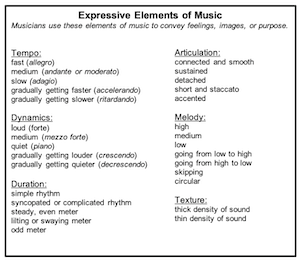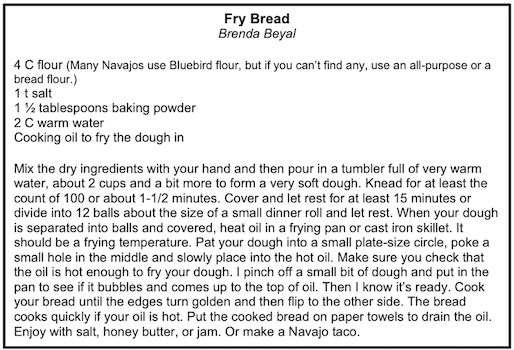SUBJECTS
GRADE
Show Results
Fry Bread
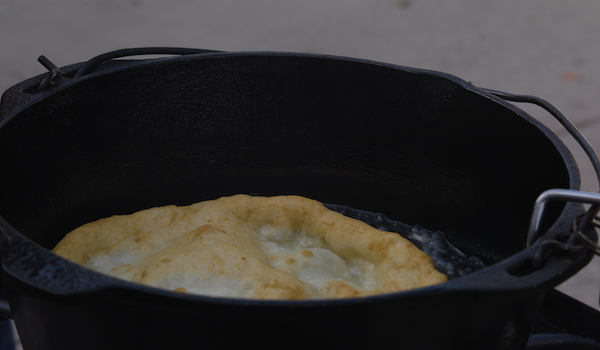
Lesson Summary
- Learn the history of fry bread
- Create a soundscape
- Interact with two contrasting pieces of music about fry bread
Lesson Plan and Procedure
Lesson Key Facts
- Grade(s): 2, 3, 4, 5, 6
- Subject(s): English Language Arts, Music, Social Studies, Native American
- Duration of lesson: Multiple lesson segments ranging from 5-20 minutes each
- Author(s): Jennifer Purdy and Brenda Beyal
Before teaching this lesson, please explain to your students that while there are many Native tribes in the United States, this lesson specifically focuses on experiences of the Navajo nation within Utah and does not represent other Indigenous groups, unless specifically identified. Jen Purdy and Brenda Beyal consulted with Connor Chee in crafting this lesson to provide expertise, accuracy, and authenticity.
While fry bread creation is connected with the Navajo Long Walk, it has now become an intertribal food, meaning different tribes across many regions make and eat fry bread. However, we have still tried to share the individual tribal aspects of the food where possible, reinforcing that there are many different Native tribes across North America, not just one Native American group.
The lesson activities are meant to be taught over a series of class periods. Teachers may choose which ones to include in their own classrooms.
Introduction and Personal Connection
(5 minutes)
Teacher: Every region of the world eats some form of bread as a cultural staple. You may be part of a family culture, a neighborhood culture, a regional, national, or ethnic culture. What kind of bread do you eat in your family, national, or ethnic culture?
Students share their responses with the entire class, a buddy, or a small group.
Activity 1: The Story of Fry Bread
(3 minutes + discussion time)
Show the 3-minute video of Brenda Beyal's personal experience with fry bread. Give students the following prompts to consider as they watch and listen.
Teacher: As you watch the video think of something you hear, see, or notice. Think of something about which you would like to know more. Is there anything that surprises you?
"The Story of Fry Bread" video: https://youtu.be/5UqyVOnQywA
Brenda's personal experience with fry bread can deepen your students' understanding. After watching the video, discuss students' responses to the prompts. Encourage them to relate their own experiences with and connections to fry bread.
Activity 2: Fry Bread Soundscape
(5 minutes)
Teacher: We are going to watch a short video of a woman in Monument Valley, Utah making fry bread. Listen carefully for all the sounds you hear. I will have you tell me the sounds after we watch.
Show the first 65 seconds of this video: "Cooking Fry Bread-Navajo Traditions Monument Valley"
Teacher: What sounds did you hear?
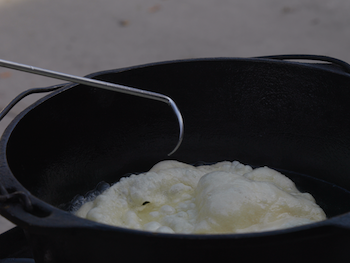 Write students' responses for all to see. The list may include:
Write students' responses for all to see. The list may include:
- crackling fire
- woman speaking
- children playing/laughing
- patting and stretching the dough
- fry bread sizzling in the pan
Have students share ideas of how they could replicate or represent each sound using:
- voices
- body percussion (clapping, snapping, stomping, and so on)
- found sounds (making sounds with nearby objects such as crumpling paper, tapping a pen on a desk, slamming a door, and so on)
Divide students into four groups.
- crackling fire
- children playing/laughing
- patting dough
- fry bread sizzling
Each group decides how to represent or make their assigned sound using voices, body percussion, found sounds, or a combination of all three.
Form
(5 minutes)
Teacher: Before we decide on the structure, or form, for our fry bread soundscape, we are going to quickly learn how to label form in music. Letters can be used to label the structure or form of any piece of music. Each section of the music is labeled with a letter, the first section being labeled A. The next section of the piece that is very different from A is labeled B. Sections that are not like either A or B are labeled C, and so on. Sections may be referred to by letters, but also often have generic names such as introduction and coda. An introduction is a section that helps start the piece. A coda is an added ending. Each of our four groups is a different section in our soundscape.
Determine and display in letters the soundscape's form and have students follow the form as they perform their "Fry Bread Soundscape." The teacher points to each section and "conducts" so each group knows when to start and stop. You may want to layer the sounds "A" (crackling fire) + "B" (children) + "C" (patting) + "D" (sizzling) or use a form such as rondo form ABACADA. (See Activity 5 for more information about rondo form.)
Discuss with students how they want their soundscape to sound.
Teacher: Do you want an introduction? Do you want a coda? Do you want to repeat any parts of the soundscape?
Experiment with various forms by rearranging the letters representing the form or by layering the sounds in different ways. Have students decide which form they like best and explain why.
Here is one example of form:
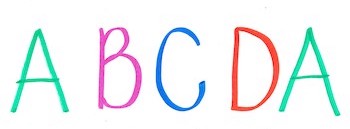
Evaluate
(3 minutes)
Have students review their performance and determine if there are changes they would like to make. Repeat the soundscape incorporating any desired changes. Some things to consider while evaluating include:
- Did the groups start, stop, and stay together?
- Did students follow the form?
- Did each group perform using the dynamic markings?
- Did each student contribute to the performance?
- What did you like? What would you change?
Activity 3: Fry Bread Rhythmic Gestures
(5 minutes)
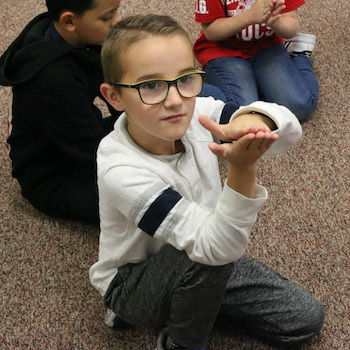 Create gestures for the steps of making fry bread. Say the words as a chant and perform the gestures to a steady beat. Repeat each gesture four times before going on to the next. Visual reminders on the "Fry Bread Cue Cards" may be helpful.
Create gestures for the steps of making fry bread. Say the words as a chant and perform the gestures to a steady beat. Repeat each gesture four times before going on to the next. Visual reminders on the "Fry Bread Cue Cards" may be helpful.
add—add the dry ingredients (baking powder, flour, salt) to the bowl. You may choose to show a sprinkle of salt, a pinch of baking powder, or handfuls of flour.
pour—pour water into the bowl
mix—mix it all together in the bowl with your hand in a circular motion
pat—pat the dough into flat circles
fry—carefully place the dough into hot oil, turn it over
eat—eat your warm and fluffy fry bread
All chant to a steady beat while doing gestures:
add, add, add, add
pour, pour, pour, pour
mix, mix, mix, mix
pat, pat, pat, pat
fry, fry, fry, fry
eat, eat, eat, eat
Activity 4: Fry Bread Song Play-Along
(5 minutes)
First practice clapping or playing this 8-beat rhythm while saying the words.

Keith Secola is a contemporary folk and blues musician. His musical style draws on his Anishinaabe heritage. He wrote this song about Fry Bread: https://www.youtube.com/watch?v=1Uyq4a-60LI&list=RDslBXmQ4djNw&index=5
This activity is a play-along, where you will use gestures and body percussion to play along with the music. Use the gestures from the chant and the 8-beat rhythm above. Perform all actions on the beat. The "fry bread clap" is clapping as if you were patting out fry bread dough.
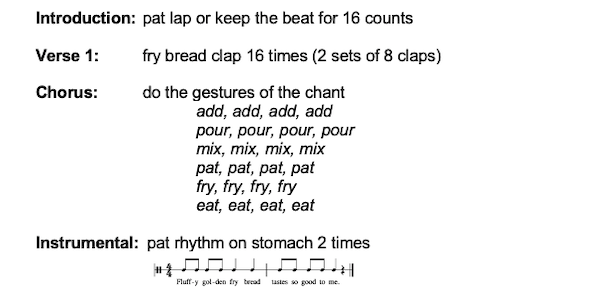
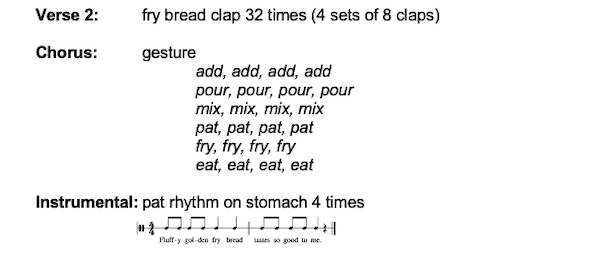
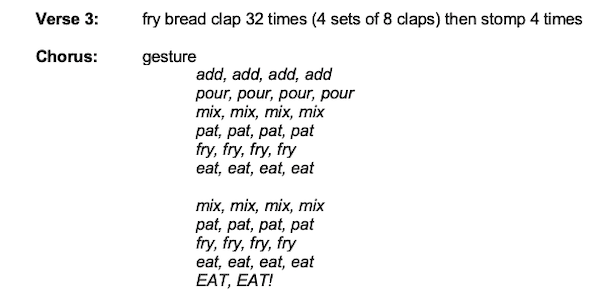
Activity 5: "Fry Bread" by Connor Chee
Activities 1, 2, 3, and 4 will help prepare students for this activity.
In September 2020, Navajo pianist and composer Connor Chee released an album featuring his piano pieces that reflect Navajo life and culture. Explore his personal story of fry bread told through music.
Expressive Elements of Music
(15 minutes)
This lesson is based on prior knowledge of music elements. Review these basic elements of music, or visit this website for more detailed information.
Descriptions and Inferences/Thinking Musically
(20 minutes)
Before listening to the piano piece called "Fry Bread," we're going to make inferences, create descriptions, and make musical interpretations as we study pictures of how fry bread is made.
Display "Fry Bread Scenes" either as a slide show or as printed cards. Students describe how they would express each picture through music. Encourage descriptive words, figurative language, and sensory details. Challenge students to "translate" their descriptions into the language of music using expressive elements of music such as tempo, articulation, dynamics, duration, melody, and texture. What would their written descriptions "sound" like? Notate the class' ideas for them to all see on the "Fry Bread Worksheet."
Now watch and listen to the video "Fry Bread" by Connor Chee. (3 minutes)
Students compare their ideas and descriptions on the "Fry Bread Worksheet" to the way Connor Chee expresses each scene through his music.
Teacher: What were your favorite parts of the piano piece? What parts sounded the way you thought they would? What was different than you imagined? Is there anything that surprised you?
Form
(5 minutes)
Music is organized into patterns. One common musical pattern, or form, is called rondo form. Rondo form is the pattern ABACADA where A is the main theme, then something different (B), return of the main theme (A), then something different (C), main theme (A), something different (D), then finally the main theme again (A).
Connor Chee used rondo form for his piano composition "Fry Bread."
A motive (or motif) in music is a short musical idea. This is the motive of the main theme (A) in "Fry Bread."

Watch Connor Chee's "Fry Bread" video one more time and listen for the motive of the main theme as it appears in this pattern or form:
Introduction
A = Main Theme—ingredients with rising arpeggio for pouring flour
B = Theme 2 (circular melody) sifting
A = Main Theme—turning bowl and mixing wet heavy dough by hand
C = Theme 3—dough is getting lighter, lighting the cooking flame and preparing oil/shortening
A = Main Theme (rhythmic accompaniment variation)—patting and forming bread
D = Theme 4 (bubbly)—frying dough in hot oil
A = Main Theme (restatement of the motive)
Activity 6: Compare and Contrast
(12 minutes)
Compare and contrast the song "Fry Bread" by Keith Secola and the piece "Fry Bread" by Connor Chee. How are they alike? Different? Consider timbre (instruments/voices), form, beat vs. rhythm, mood, dynamics, tempo, melody, and texture (the density of the sound).
Teachers may choose to use a graphic organizer and/or a Venn diagram for this lesson segment.
Activity 7: Fry Bread Book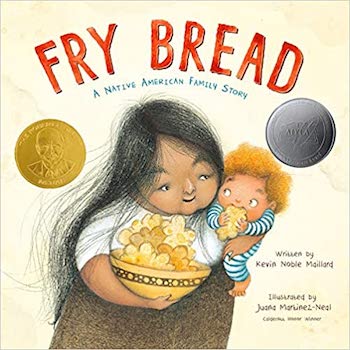
(10 minutes)
Refer to the book "Fry Bread: A Native American Family Story" by Kevin Noble Maillard or the video of the author reading the book. If desired, the illustrations are easier to see in this read-aloud version.
NOTE: The author of the book is a member of the Mekuskey band of the Seminole Nation. Some of the traditions and descriptions of his fry bread may differ from those of other Native American tribal nations. Every tribal nation has made their own adaptations to the recipe and traditions of making fry bread.
Look for figurative language, descriptive words, and adjectives.
Older grades will appreciate the information contained in the Author's Note at the back of the book. Encourage them to make connections to their own lives and to other content areas.
The last page of the book reads, "Fry bread is YOU." Use this statement as a basis for discussion and collaborative conversations.
Optional Extension Activity
Make and eat fry bread. Refer to the traditional Navajo recipe from Brenda Beyal.
Learning Objectives
- Learn the history of fry bread.
- Experience personal stories of fry bread expressed orally, through music, and through written text.
- Create a soundscape.
- Create a pattern or musical form.
- Follow and experience rondo form.
- Perform a rhythmic sequence to a beat.
- Use expressive musical elements to perform and interpret music.
- Use descriptive and figurative language to describe and interpret actions, images, sounds, and music.
- Listen for patterns and examples of expressive elements of music.
Utah State Board of Education Standards
This lesson can be used to meet standards in many grades and subject areas. We will highlight one grade's standards to give an example of application.
Grade 4 Music
- Standard 4.M.CR.4: Select and demonstrate musical ideas to express intent while connecting to purpose and context.
- Standard 4.M.CR.5: Organize personal musical ideas using iconic notation or recordings to combine and/or sequence personal rhythmic and melodic ideas.
- Standard 4.M.P.7: Perform and identify rhythm patterns in two-, three-, and four-beat meters using body percussion, voice, and simple instruments.
- Standard 4.M.P.8: Respond with body percussion, voice, or simple instruments to visual representation of rhythm patterns.
- Standard 4.M.R.1: Listen to and interact with a variety of contrasting music.
- Standard 4.M.R.2: Recognize form, meter, beat vs. rhythm, timbre, mood, dynamics, tempo, melody, texture, and harmony/tonality.
- Standard 4.M.R.4: Describe feelings or imagery conveyed by a music selection.
- Standard 4.M.R.5: Identify and describe elements that make contrasting music selections different from each other.
- Standard 4.M.CO.2: Draw upon interests, knowledge, and skills developed to inspire and inform the creation, performance, and appreciation of music, and deepen understanding of another content area through music.
- Standard 4.M.CO.3: Experience and explore music which connects us to history, culture, heritage, and community, and identify connections between a music genre and cultural or historical contexts.
Grade 4 Social Studies
- Standard 4.5.6: Explain one of Utah’s cultural institutions and its historical significance as well as the cultural benefits to Utah families and our nation.
- Standard 4.2.4: Investigate the reasons why early explorers and frontiersmen came to the land now called Utah, and determine how their contributions are relevant to Utahns today.
- Standard 4.4.6: Use case studies to explain how national or global events between 1896–1999 (for example, World War I, the Spanish Flu Epidemic, the Great Depression, World War II, Japanese American Incarceration, the Cold War, civil rights movements, Americans with Disabilities Act) had an impact in their local communities and state.
Grade 4 English Language Arts
- Standard 4.R.8: Determine the meaning of words, phrases, figurative language, academic and content-specific words within a text. (RL & RI)
- Standard 4.R.9: Determine or clarify the meaning of unknown and multiple-meaning words and phrases, choosing flexibly from a range of strategies. (RL & RI)
a. Use context as a clue to the meaning of a word. - Standard 4.R.12: Compare a visual or oral presentation of a story or drama with the text itself and identify where each version reflects specific descriptions and directions in the text. (RL) Interpret information presented visually, orally, or quantitatively and explain how the information contributes to an understanding of the text in which it appears. (RI)
- Standard 4.R.14: Compare the treatment of similar themes and topics and patterns of events in stories, myths, and traditional literature from different cultures. (RL) Integrate information from two texts on the same topic in order to write or speak about the subject knowledgeably. (RI)
- Standard 4.W.3: Write narrative pieces to develop real or imagined experiences or events using effective technique, descriptive details, clear event sequences, and provide a resolution.
- d. Use concrete words, phrases, complex sentences, and sensory details to convey experiences and events precisely.
- Standard 4.SL.1: Participate effectively in a range of conversations and collaborations, using age-appropriate vocabulary, on topics, texts, and issues.
Equipment and Materials Needed
- "The Story of Fry Bread" video: https://youtu.be/5UqyVOnQywA
- Printed Fry Bread Cue Cards for the Fry Bread Gestures activity (optional)
- Keith Secola "Fry Bread" song: https://www.youtube.com/watch?v=1Uyq4a-60LI&list=RDslBXmQ4djNw&index=5
- Fry Bread Worksheet and/or Fry Bread Scenes (may be shown as a slide show or printed as cards to display)
- Connor Chee "Fry Bread" video: https://www.youtube.com/watch?v=7fItjTPtPEk
- "Fry Bread: A Native American Family Story" by Kevin Noble Maillard with illustrations by Juana Martinez-Neal
- A video of the author reading the book: https://www.youtube.com/watch?v=ZGoPq2CeJdw&t=116s
- Another read-aloud version that clearly shows the illustrations: https://www.youtube.com/watch?v=MibEeGiFThM
Additional Resources
This lesson was created thanks to a grant from the National Endowment for the Arts and the Utah Division of Arts & Museums.
- Advancing Arts Leadership | Music Elements and Concepts: http://advancingartsleadership.com/node/16#musicelementsandconcepts
- Information about the history of fry bread: https://www.mentalfloss.com/ar
ticle/637618/fry-bread-controv ersial-history
Image References
Images 1-2: Adam Sanders
Images 3-4: Jen Purdy
Image 5: James Huston
Images 6-8: Jen Purdy
Image 9: https://www.amazon.com/Fry-Bread-Native-American-Family/dp/1626727465
Image 10: Brenda Beyal

www.education.byu.edu/arts/lessons
 Download
Download